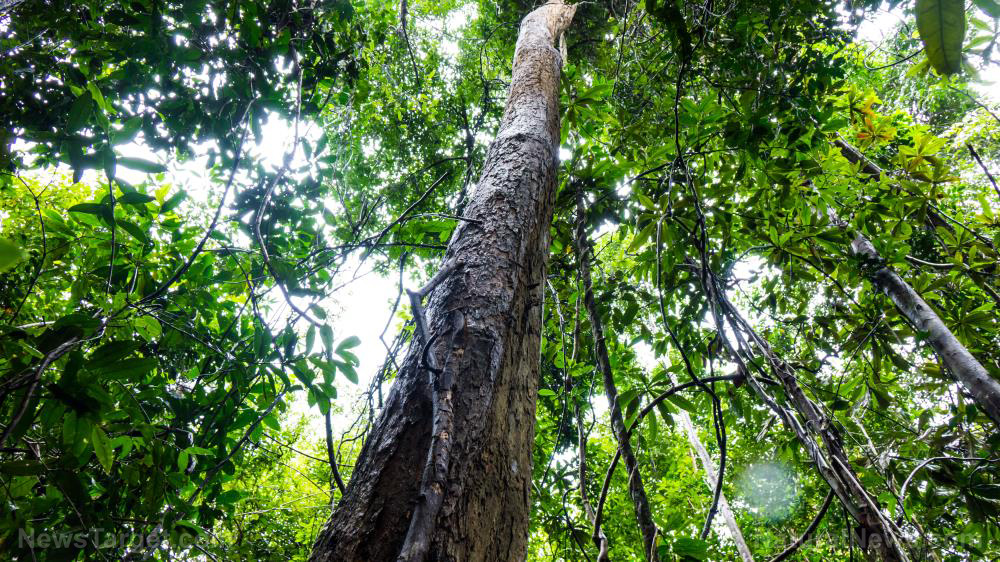Water availability: The single most important factor behind plant potential
09/05/2019 / By Stephanie Diaz

Some people might think that extremely tall trees have a hard time transporting water from their roots all the way up to their top leaves. However, a recent research published in Science Advances found that plant height and xylem hydraulic traits are linked to the availability of habitat water across different terrestrial biomes.
Darcy’s law
Previous studies on tall trees have shown that hydraulic resistance is associated with plant height. This means that hydraulic resistance limits how far water can travel through the xylem to top leaves. Consequently, hydraulic resistance sets the maximum height a tree can grow in a certain habitat. However, what scientists did not understand is how this physiological coordination worked within a broad range of species and environment.
To find out, researchers from South China Botanical Garden, Chinese Academy of Sciences collated data on 1,281 different tree species from 369 sites all over the world. From this, they built multiple models, which links height, hydraulic traits, and water. The researchers found that taller species of trees from wet habitats have greater xylem efficiency and wider conduits, as well as lower hydraulic safety, conduit density, and sapwood density.
“People used to think that taller plants might transport water less efficiently because of their longer distances,” said Liu Hui, the lead author of the study. “Instead, we found that taller plants had higher hydraulic conductivity across species, which was a main strategy they employ to compensate for the high evaporative demand by leaves and the increased height. It is called Darcy’s Law.”
Hui added that before their research, many of the hydraulic theories like Darcy’s law were based on information within species. However, the results of their study identified and explained different hydraulic patterns among and across species.
“Simply put, patterns found within species are based on short-term adaptive responses and are largely shaped by physiological trade-offs or constraints, while patterns across species reflect intrinsic evolutionary differences, which may be formed over millions of years, and are mainly constrained by their environmental niches,” Hui explained.
“Our findings greatly extend human knowledge about the relationship between xylem hydraulic traits and plant height from local studies to biomes across the globe,” said co-author Ye Qing. “We highlighted that hydraulic traits can serve as important predictors of global maximum plant height and species distribution patterns.”
The life of a tree
Trees are ubiquitous in nature, but not many people know how they grow. The life of a tree starts just like any other plant. Once tree seedlings have been planted, they begin to grow after a month. These seedlings develop a true single stem, tree-like leaves or needles, and a bark. Every part of a tree plays an intricate role, which contributes to its growth and development. (Related: California’s redwood forests capture massive amounts of atmospheric carbon dioxide.)
The root system of a tree plays a key role in collecting water, which makes life possible for trees and everything else in this world that depends on trees. The root system has tiny root hairs that are located just behind the root tip that absorbs moisture, as well as dissolved minerals.
The trunk of a tree is essential for limb support and root-to-leaf nutrient and moisture transport. The trunk grows as it searches for moisture and sunlight. Its importance in protecting trees cannot be stressed enough. Many trees die because their bark has been damaged by insects, pathogens, environmental causes, and other external factors.
The leafy crown of a tree is where bud formation takes place. The tree bud is a small collection of growing tissues that eventually develop into leaves, flowers, and branches. The leaves, in particular, are responsible for photosynthesis – a process that uses sunlight to convert carbon dioxide and water into sugar.
For more information about trees and the important role they play on the health of the environment, visit Environ.news.
Sources include:
Tagged Under: conduit density, Darcy's Law, environment, hydraulic conductivity, hydraulic resistance, hydraulic safety, hydraulic traits, maximum tree height, phloem, photosynthesis, research, root system, sapwood density, tall trees, xylem
RECENT NEWS & ARTICLES
COPYRIGHT © 2017 CLIMATE SCIENCE NEWS


















